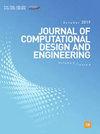Self-supervised feature matched virtual try-on
IF 6.1
2区 工程技术
Q1 COMPUTER SCIENCE, INTERDISCIPLINARY APPLICATIONS
引用次数: 0
Abstract
Abstract Virtual try-on is a technology that enables users to preview the effect of wearing a target garment without wearing the actual garment. However, existing image-based virtual try-on methods often require additional human parsing or segmentation operations to generate intermediate representations required for garment deformation and texture fusion. These operations not only increase the computational complexity and memory consumption, but also limit the real-time and portability of virtual try-on. Additionally, inaccurate parsing results can lead to misleading final generated images. To overcome these challenges, we propose a self-supervised feature matched virtual try-on network, which can directly generate high-quality try-on results from human body images and target clothing images without any additional input. Specifically, we design an optical flow warp module, which focuses on the optical flow changes between the person image and the clothing image to achieve accurate clothing alignment and deformation. Furthermore, a feature refine warp module is designed to enhance the features of the extracted optical flow information and the original character segmentation and analysis operations, reducing the influence of background clutter features on the content, and ensuring that the wrinkles and deformation of the replacement clothes are close to the original clothes. The feature match module is developed to calculate the feature matching loss of the converted clothing and the generated results of the teacher network and the student network, and the corresponding knowledge is distilled and passed to the student network to assist in self-supervised training. We conduct experiments on the VITON dataset and show that our model can generate high quality and high resolution, and our proposed method outperforms the state-of-the-art virtual try-on methods both qualitatively and quantitatively.自监督功能匹配虚拟试穿
虚拟试穿是一种使用户在不穿实际服装的情况下,可以预览穿目标服装效果的技术。然而,现有的基于图像的虚拟试穿方法通常需要额外的人工解析或分割操作来生成服装变形和纹理融合所需的中间表示。这些操作不仅增加了计算复杂度和内存消耗,而且限制了虚拟试戴的实时性和可移植性。此外,不准确的解析结果可能导致最终生成的图像具有误导性。为了克服这些挑战,我们提出了一种自监督特征匹配的虚拟试戴网络,该网络可以直接从人体图像和目标服装图像中生成高质量的试戴结果,而无需任何额外的输入。具体而言,我们设计了一个光流翘曲模块,该模块主要关注人物图像与服装图像之间的光流变化,以实现服装的精确对准和变形。进一步设计特征细化经纱模块,增强提取的光流信息和原始字符分割分析操作的特征,降低背景杂波特征对内容的影响,确保替换衣服的褶皱和变形与原始衣服接近。开发特征匹配模块,计算转换后的服装的特征匹配损失与教师网络和学生网络的生成结果,并将相应的知识进行提炼传递给学生网络,以辅助自监督训练。我们在VITON数据集上进行了实验,结果表明我们的模型可以产生高质量和高分辨率,并且我们提出的方法在定性和定量上都优于目前最先进的虚拟试戴方法。
本文章由计算机程序翻译,如有差异,请以英文原文为准。
求助全文
约1分钟内获得全文
求助全文
来源期刊

Journal of Computational Design and Engineering
Computer Science-Human-Computer Interaction
CiteScore
7.70
自引率
20.40%
发文量
125
期刊介绍:
Journal of Computational Design and Engineering is an international journal that aims to provide academia and industry with a venue for rapid publication of research papers reporting innovative computational methods and applications to achieve a major breakthrough, practical improvements, and bold new research directions within a wide range of design and engineering:
• Theory and its progress in computational advancement for design and engineering
• Development of computational framework to support large scale design and engineering
• Interaction issues among human, designed artifacts, and systems
• Knowledge-intensive technologies for intelligent and sustainable systems
• Emerging technology and convergence of technology fields presented with convincing design examples
• Educational issues for academia, practitioners, and future generation
• Proposal on new research directions as well as survey and retrospectives on mature field.
 求助内容:
求助内容: 应助结果提醒方式:
应助结果提醒方式:


